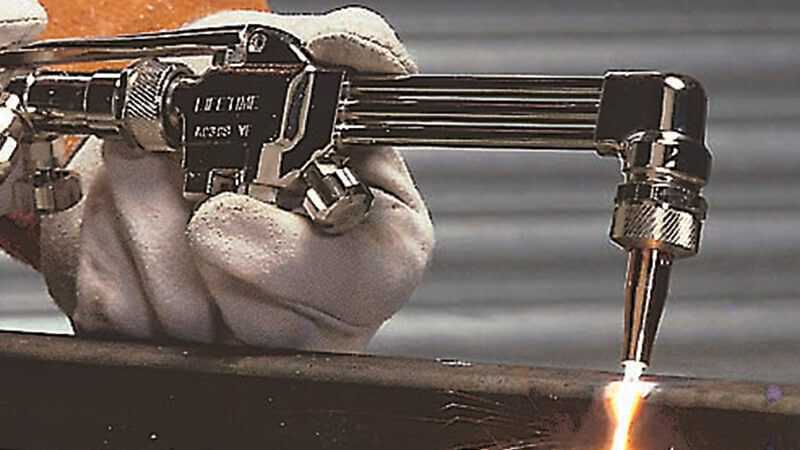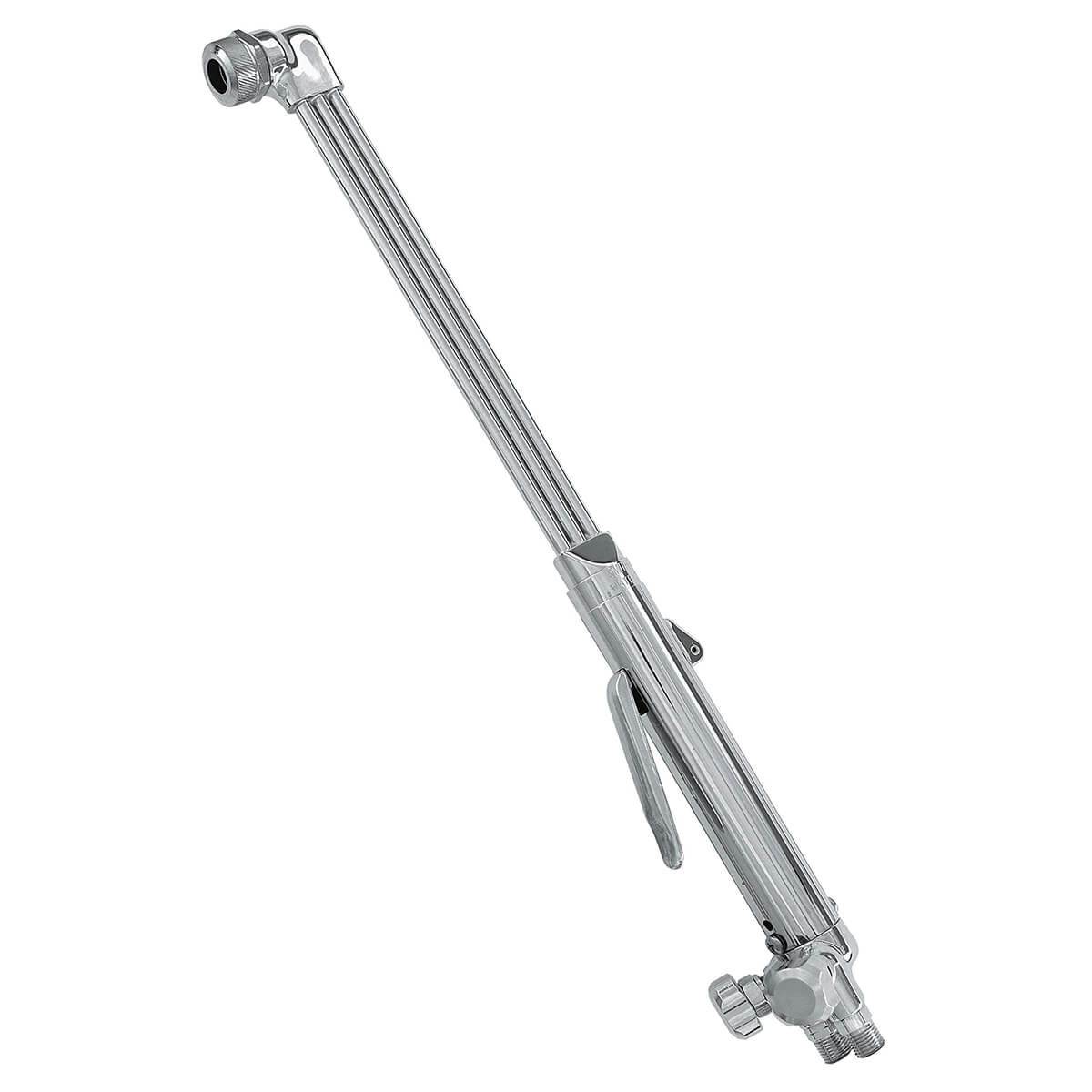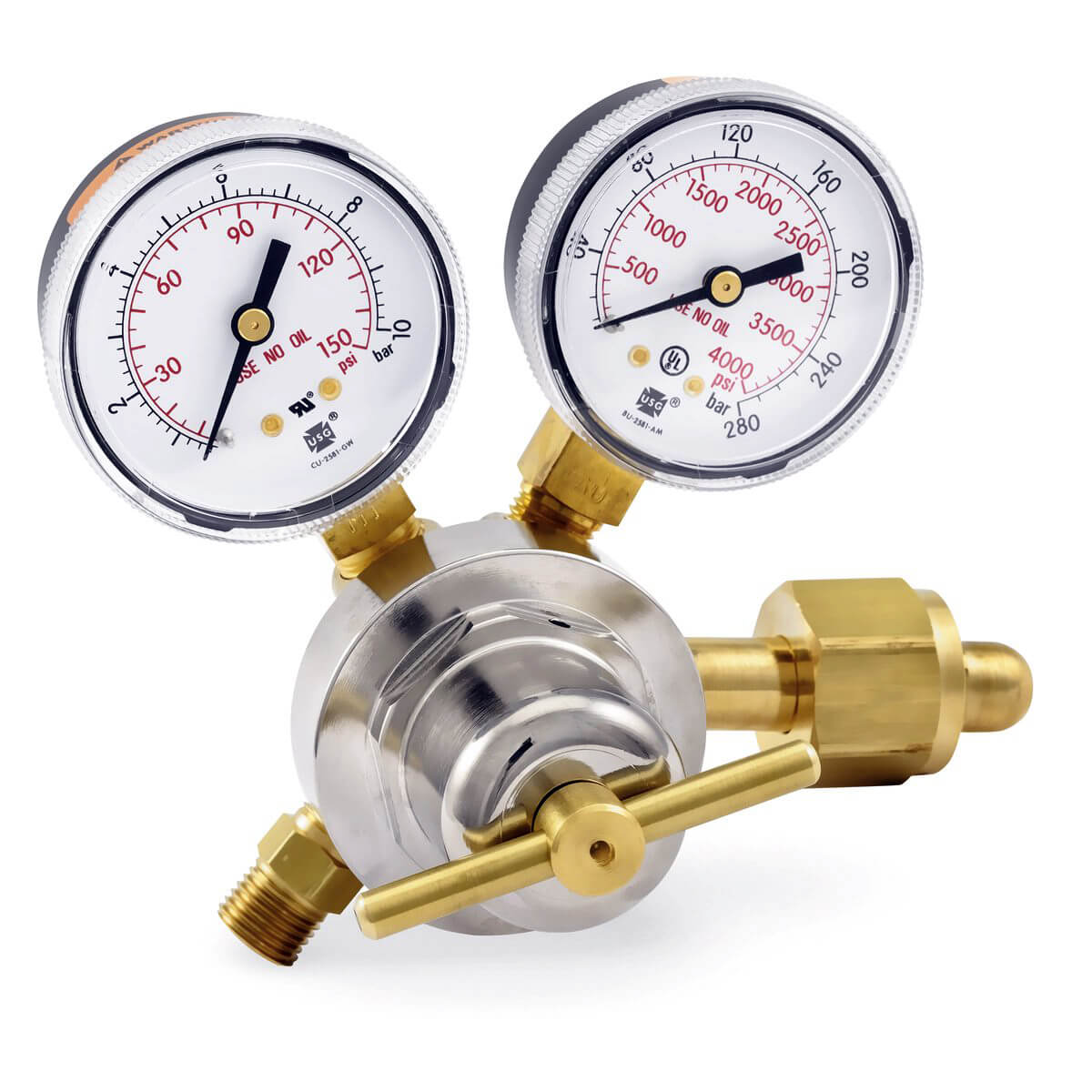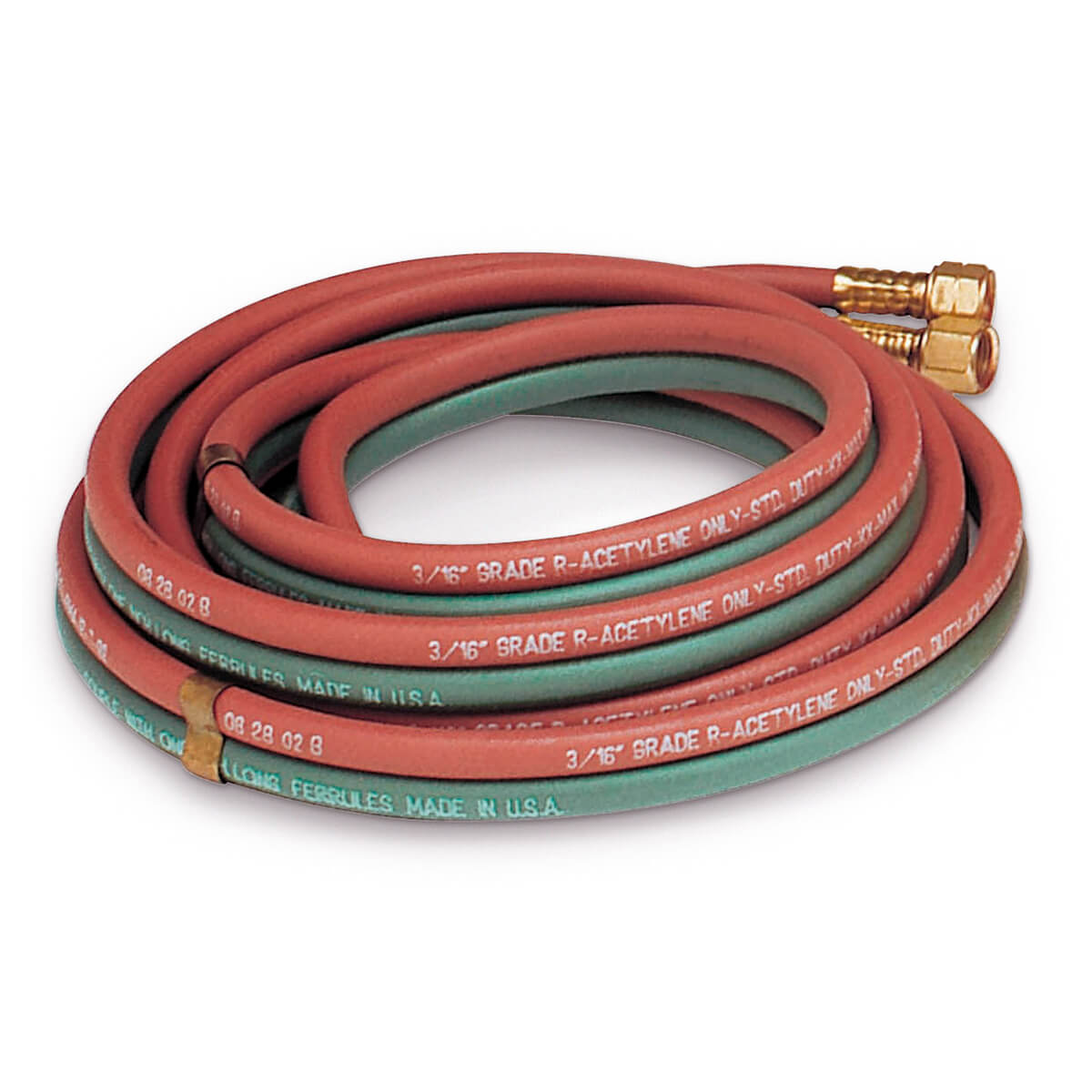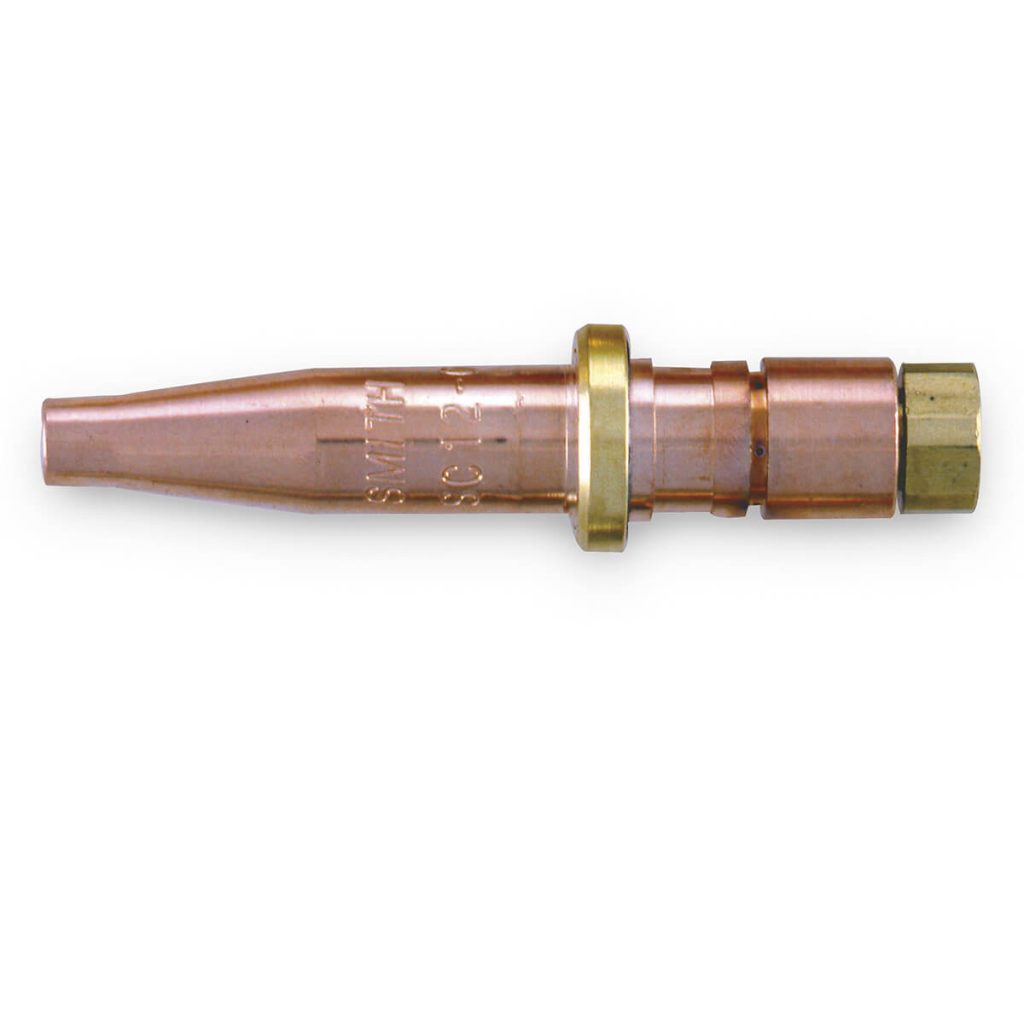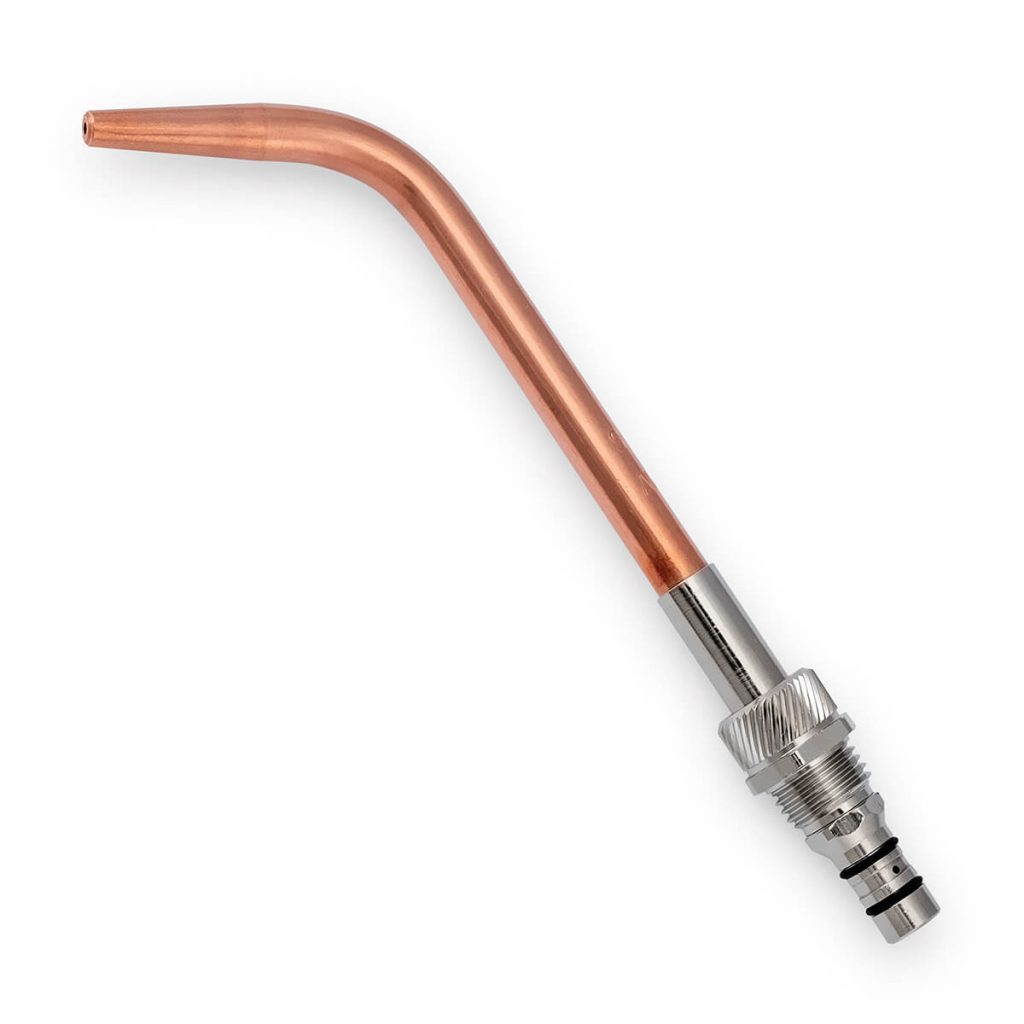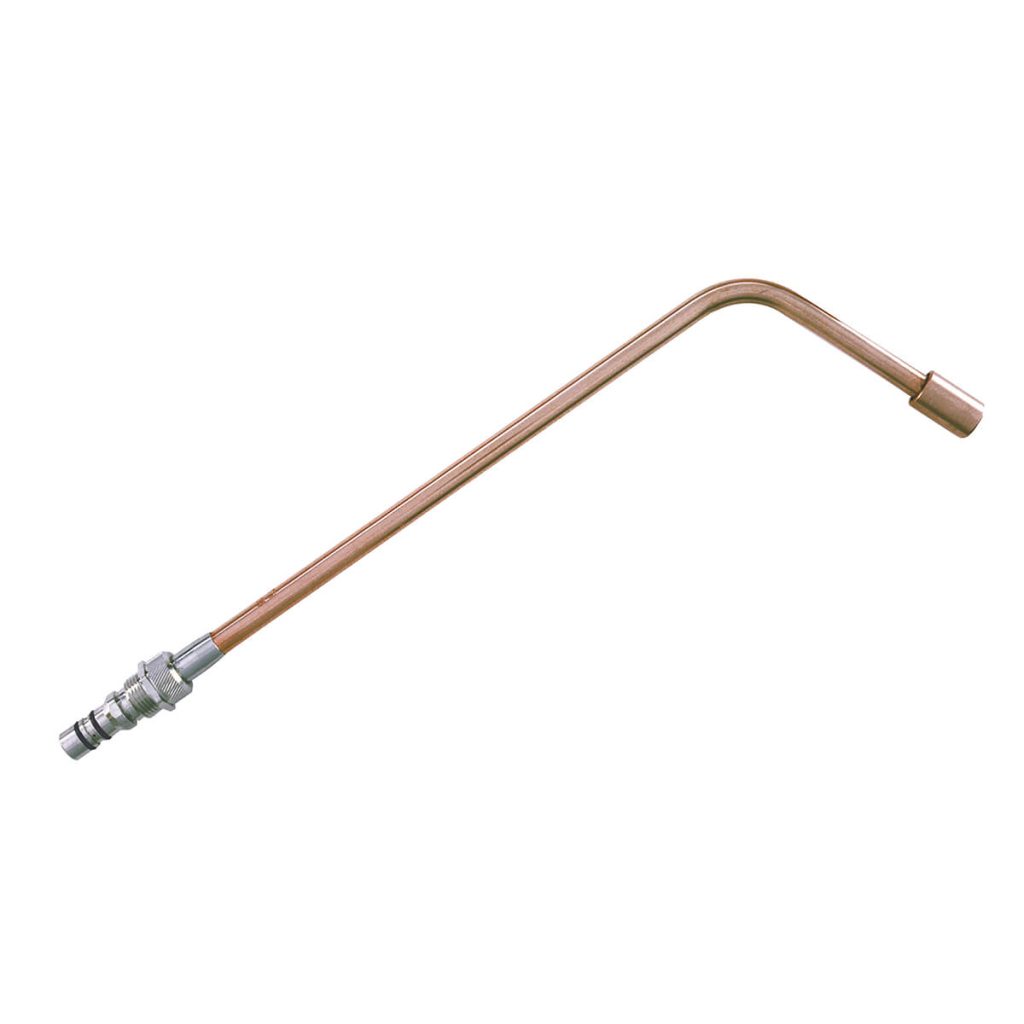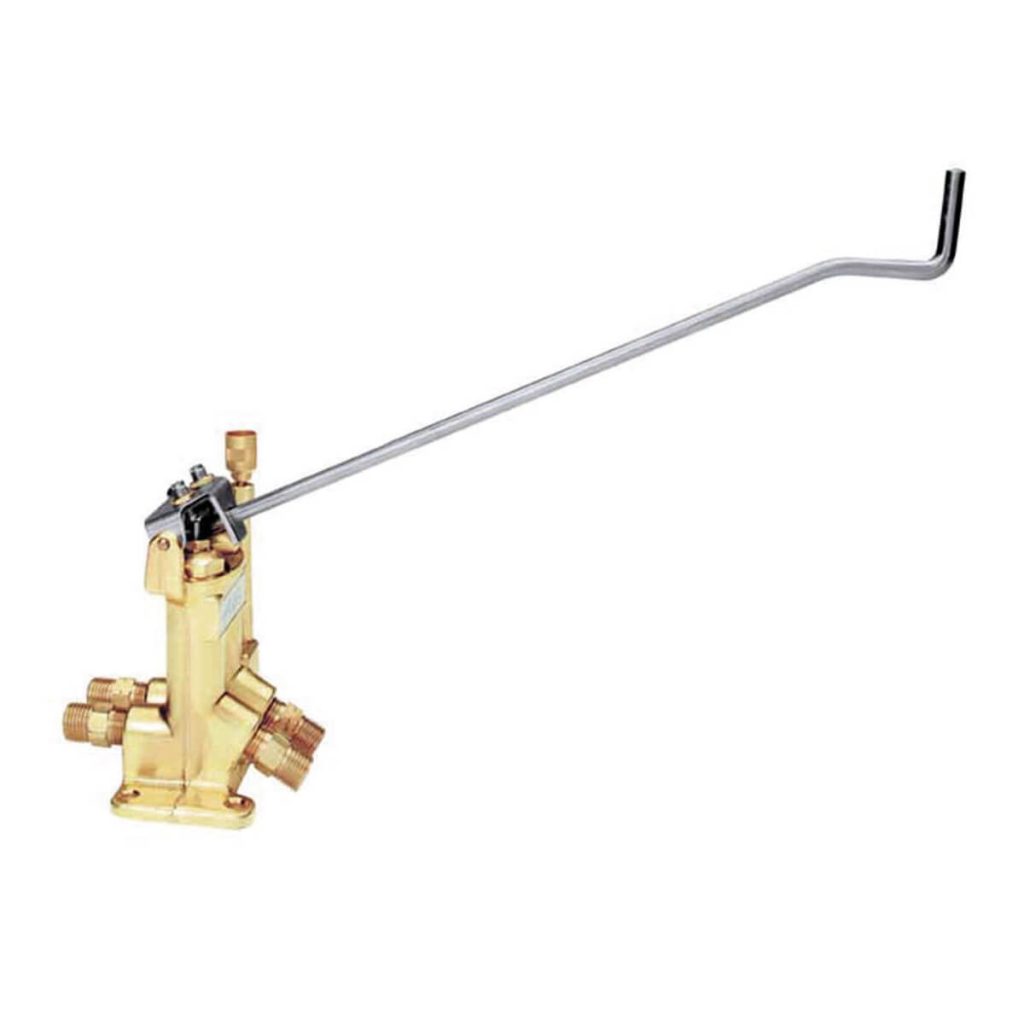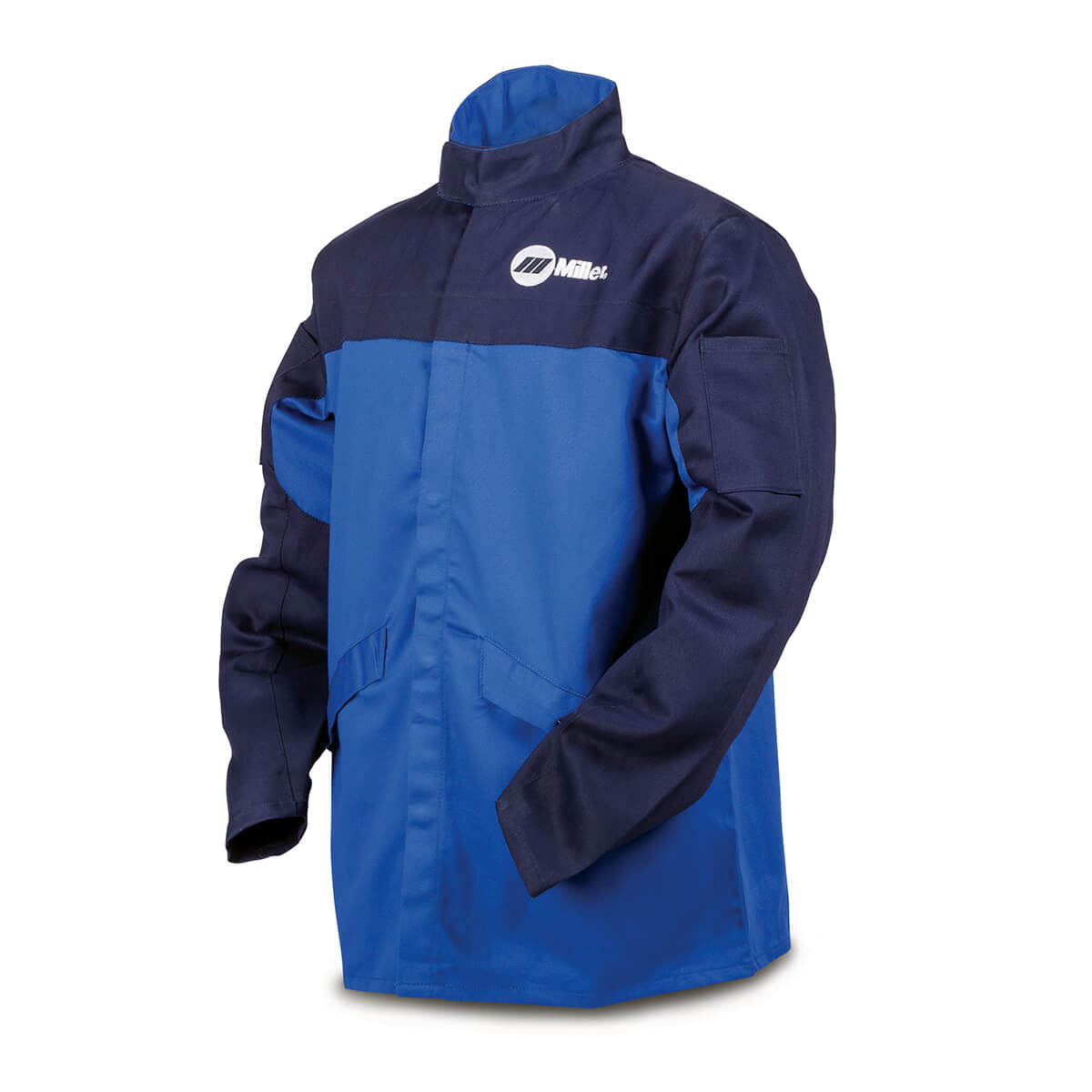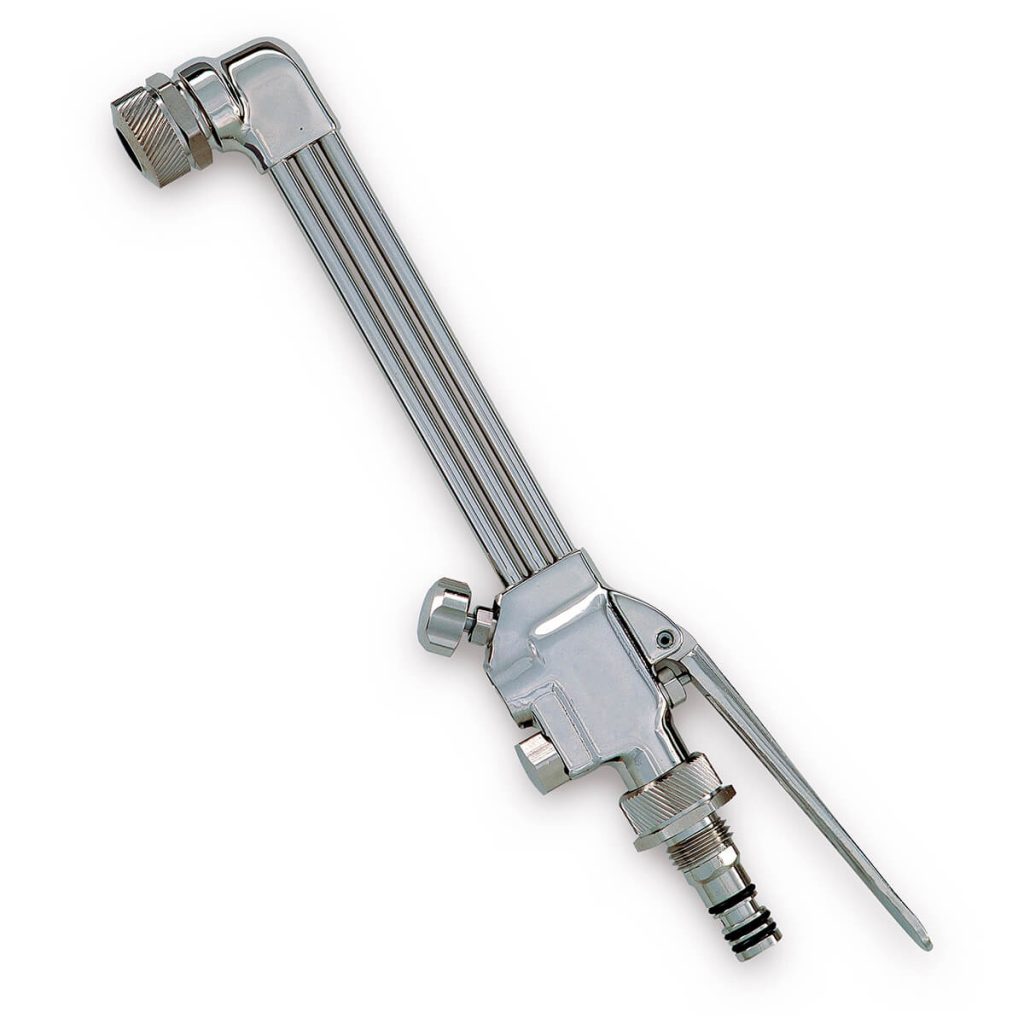Oxyfuel has been part of the welding and cutting environment since the beginning of the industrial revolution. Despite all the decades that have passed, oxyfuel is still a process used in many industries, mainly to cut metal through.
Even though oxyfuel can be used for both welding and cutting (by changing the nozzle in the handle), the vast majority of people use it for cutting, so we are going to be referring mainly to that process in this article.
The purpose of this article is to serve as a complete guide for anyone interested in oxyfuel, regardless of the expertise level they might have. Let’s start with the basics.
What is oxyfuel?
Oxyfuel is a welding and cutting process that uses a combination of fuel gas and oxygen to create a high-temperature flame that can be used to weld or cut through metal. The fuel gas is typically acetylene, propane, or natural gas.
Basically, in the oxyfuel cutting process, the fuel gas and oxygen are mixed in a part of the torch or the tip, and then ignited. The resulting flame is directed at the metal being cut, which causes the metal to heat up and form an oxide layer. The oxygen then reacts with the metal oxide, producing a chemical reaction that releases additional heat and causes the metal to melt.
As the metal melts, the cutting torch moves along the desired cutting path, allowing the molten metal to flow out of the cut and separate the metal into two pieces.
Oxyfuel cutting is commonly used in industrial applications, such as in the construction of large metal structures or in shipbuilding. It can be used to cut through thick metal plates or to make intricate cuts with a certain degree of precision, depending on the expertise of the operator. However, oxyfuel cutting is typically slower than plasma cutting and can only be used on certain types of metals.
What is the history of oxyfuel?
Oxyfuel has a long history dating back to the 19th century. The basic principles of oxyfuel were first discovered in the mid-1800s by various inventors, and the process evolved over time as new materials and techniques were developed.
One of the early pioneers of oxyfuel was Edmund Davy, who in 1836 patented the “oxy-hydrogen blowpipe,” which used a mixture of oxygen and hydrogen gases to create a high-temperature flame for welding and cutting. However, this process had limitations in terms of flame stability and heat output, and it was not widely adopted for industrial applications.
In the late 1800s, acetylene gas was discovered, which proved to be a more suitable fuel for oxyfuel due to its higher flame temperature and stability. Acetylene was first commercially produced in the 1890s, and it quickly gained popularity as a fuel for oxyfuel welding and cutting due to its ability to generate a hot and stable flame.
With the availability of acetylene as a fuel, oxyfuel welding became widely used in various industries, including shipbuilding, construction, and manufacturing. The process was used for a wide range of applications, from joining metals in fabrication and repair work to cutting through thick steel plates for shipbuilding and structural steel construction.
In 1903, French engineers Edmond Fouché and Charles Picard developed the oxyacetylene torch, which used a mixture of acetylene gas and oxygen to create a high-temperature flame that could be used to cut through metal. The oxyacetylene torch quickly gained popularity due to its versatility and ability to cut through a wide range of metals.
Over the years, oxyfuel has evolved with advancements in technology, such as the development of new gases, improved torch designs, and more efficient regulators and hoses.
Today, oxyfuel is still used in various industries and applications, although it has faced competition from other welding processes, such as arc welding and plasma cutting, which offer advantages in certain situations. However, oxyfuel remains a valuable and widely used process for many welding and cutting applications, particularly in situations where portability, simplicity, and cost-effectiveness are important factors.
How does oxyfuel work?
The oxyfuel process uses a combination of fuel gas and oxygen to create a high-temperature flame that can be used to cut through metal. The process involves the following steps:
- Gas supply: The fuel gas, typically acetylene, propane, or natural gas, is stored in a tank and mixed with oxygen as it is fed into the torch. The mixing of the gas can occur in different areas of the torch, depending on the manufacturer.
- Ignition: The mixed gas and oxygen are ignited in the torch, creating a high-temperature flame.
- Preheating: The torch is used to preheat the metal to be cut. This softens the metal and makes it easier to cut.
- Cutting: Once the metal has been preheated, the torch is moved along the cutting line. The oxygen from the torch reacts with the metal, causing it to burn and creating a chemical reaction that releases additional heat. This melts the metal and allows the torch to cut through it.
- Slag removal: As the metal is cut, it forms a molten layer called slag. The slag is removed as it cools and solidifies.
The oxyfuel process is effective for cutting through thick metals, such as steel, as well as for cutting metals that are difficult to cut with other methods, such as cast iron. However, it is slower than some other cutting methods and may produce rougher edges on the cut metal.
The gases involved in the oxyfuel process
Besides oxygen, which is a constant in oxyfuel, and should have a purity of at least 99.5%, there are other 4 gases that might be involved. They are:
Acetylene: It is a colourless and flammable gas widely used in oxyfuel. It is the hottest gas to use in oxyfuel, but it can be unstable at some points and expensive.
Propane: It is part of the group also knwon as liquefied petroleum gas (which can be shortened as “LP” or “LPG”). It’s a byproduct of natural gas processing and petroleum refining. It’s clean, powerful, safe, and reliable. Its price is an advantage, and it’s clean-burning but it is not as hot as other gases.
Propylene: It is part of the group also knwon as liquefied petroleum gas as well. It is hotter than propane, but not as hot as acetylene, so remains as an average option.
MAPP: The complete name for this gas is methylacetylene-propadiene, so with such a long name it is no wonder that is known only as MAPP. It is a fuel gas based on a stabilized mixture of methylacetylene (propyne), propadiene and propane. MAPP gas is widely regarded as a safer and easier-to-use substitute for acetylene. Its production ended in 2008, so many current products labeled “MAPP” are, in fact, MAPP substitutes.
Natural Gas: Natural gas is a fossil fuel energy source. Natural gas is composed mainly of methane and it can also contain small amounts of natural gas liquids (NGLs, which are also hydrocarbon gas liquids), and nonhydrocarbon gases, such as carbon dioxide and water vapor. This gas is more economic than the other options and it is easily found, but is not as hot as acetylene, and the delivery pressure is low.
What is a Flashback?
Flashback is the condition of the flame propagating down the hoses of an oxy-fuel welding and cutting system. To prevent such a situation a flashback arrestor is usually employed.
The flame burns backwards into the hose, causing a popping or squealing noise. It can cause an explosion in the hose with the potential to injure or kill the operator. Using a lower pressure than recommended can cause a flashback.
What are the advantages of oxyfuel?
Oxyfuel have been around as an industrial process for more than 100 years, evidently because it has a list of advantages. We can mention the following ones:
Versatility: It can be used to cut through a wide range of metals, including thick metals that are difficult to cut with other methods.
Portability: Oxyfuel equipment is generally more portable than other cutting methods, which makes it useful for on-site cutting operations.
Cost-effective: It is generally less expensive than some other cutting methods, which makes it a cost-effective option for some applications.
Simple operation: The process is relatively simple to operate and requires minimal training compared to other cutting methods.
No electricity required: Oxyfuel cutting does not require electricity, which makes it useful in situations where power is not available or where electric equipment cannot be used safely.
Good edge quality: It produces a relatively smooth edge on the cut metal, which can reduce the need for additional finishing operations.
Due to its advantages, oxyfuel cutting is a reliable and effective cutting method that has been used for many years in various industries. While it may have some limitations compared to newer cutting methods such as plasma, it remains a valuable option for cutting thick metals and for applications where portability and simplicity are important.
What are the disadvantages of oxyfuel?
Nothing in this world is perfect, including oxyfuel. So, despite its advantages, the oxyfuel process also has several disadvantages, including:
Limited precision: It is not as precise as other cutting methods such as plasma, which can make it unsuitable for some applications that require high precision.
Slow cutting speed: It is generally slower than other methods, which can make it less efficient for cutting large volumes of material.
Rough edges: While oxyfuel can produce relatively smooth edges, the edges may still be rougher than those produced by other cutting methods such as laser cutting.
Limited range of materials: It is generally only effective for cutting certain types of metals and may not work well on other materials such as plastics or ceramics.
Safety concerns: The oxyfuel cutting process involves the use of flammable gases, which can pose a safety risk if not handled properly. Proper training and safety equipment are essential to ensure safe operation.
Environmental concerns: The use of fuel gases in the oxyfuel cutting process can produce harmful emissions, which can contribute to air pollution if not properly controlled.
All these disadvantages are brought up here for you to think carefully if oxyfuel is the right process for your operation. Feel free to reach out to us in case you have any further question.
What are the main uses of oxyfuel?
The oxyfuel process is commonly used in a variety of industrial applications for cutting and shaping metal. Some of the main uses of oxyfuel include:
Fabrication: It is often used in metal fabrication operations to cut and shape metal parts for machinery, vehicles, and other equipment.
Welding: It can be used to prepare metal edges for welding, by cutting the metal to the required shape and size, and to actually weld the pieces.
Demolition: It can be used to cut through metal structures, such as pipelines and storage tanks, for dismantling or demolition.
Maintenance and repair: Oxyfuel is often used for maintenance and repair work on metal equipment and structures, such as cutting out damaged sections for replacement.
Shipbuilding: It is commonly used in shipbuilding operations, particularly for cutting and shaping steel plates and sections.
Automotive repair: It can be used for cutting and shaping metal components in automotive repair work.
Artistic work: Oxyfuel can also be used in artistic applications, such as for cutting metal sculptures or decorative features.
The versatility of oxyfuel makes it a valuable tool in many different industries and applications, particularly for cutting thick metal sections that are difficult to cut with other methods. Despite that, there are situations where plasma cutting could be more ideal. Let’s see about that.
When to use oxyfuel and when to use plasma cutting?
This is, probably, the most important question this article can answer, because your choice should be based on what your needs are, instead of your preferences.
The choice between oxyfuel and plasma cutting depends on several factors, including the material being cut, the thickness of the material, and the desired cut quality. Here are some general guidelines for when to use each method:
Oxyfuel cutting is generally best for
- Cutting thick metal sections (over 1 inch thick)
- Cutting steel, iron, and other ferrous metals
- Cutting materials that are difficult to cut with plasma, such as cast iron
- Cutting in outdoor or remote locations, where electrical power may not be available
- Cutting applications where cost is a major consideration.
Plasma cutting is generally best for
- Cutting thinner metal sections (lower than 1 inch thick)
- Cutting a wide range of materials, including stainless steel, aluminum, and non-ferrous metals
- Cutting materials that require a high level of precision or a smooth edge finish
- Cutting applications where speed is a major consideration
- Cutting materials where heat distortion is a concern.
It is safe to say that both oxyfuel and plasma cutting have their strengths and weaknesses, and the choice between them will depend on the specific requirements of each cutting application
In some cases, a combination of both methods may be used, such as oxyfuel for thicker sections and plasma for thinner sections or more precise cuts. Evidently, the choice should be based on needs, not in mindless preferences.
Equipment required for oxyfuel
Oxyfuel doesn’t require a lot of equipment, so let’s review here what typically includes:
Oxyfuel torch: The oxyfuel torch is the primary tool used in oxyfuel cutting and welding. It typically consists of a handle, oxygen and fuel gas valves, a mixing chamber, and a cutting or welding tip (also known as nozzle). The torch is used to control the flow of oxygen and fuel gas, as well as the flame characteristics during welding.
Oxygen source: An oxygen source is required to provide the oxygen needed for the combustion process in oxyfuel. This can be in the form of oxygen cylinders or an oxygen generator, depending on the setup and location.
Fuel gas source: A fuel gas source is needed to provide the fuel gas used in the oxyfuel process. Common fuel gases used in oxyfuel include acetylene, propane, and natural gas. Fuel gas is typically stored in cylinders or supplied through a gas pipeline.
Gas regulators: Gas regulators are used to control the pressure of the oxygen and fuel gas as they are delivered from their respective cylinders or sources to the oxyfuel torch. They ensure a consistent and stable flow of gases during welding or cutting.
Hoses: Hoses are used to connect the gas regulators to the oxyfuel torch, allowing the controlled flow of oxygen and fuel gas from the cylinders or sources to the torch.
Cutting, Heating or Welding tips (also known as nozzles): They are attached to the torch and determine the size and shape of the flame used in the oxyfuel process. Different tips or nozzles are used depending on whether you are going to cut, heat or weld. Also, the tip or nozzle to use can depend on the type of material you are going to work with.
Ignition device: An ignition device, such as a spark lighter or a striker, is needed to ignite the fuel gas and oxygen mixture at the tip to create the flame.
Personal protective equipment (PPE): Personal protective equipment, such as goggles, gloves, and flame-resistant clothing, is essential for the safety of the operator during the oxyfuel process.
Cutting attachment (optional): If cutting is required, a cutting attachment may be needed in addition to the torch. The cutting attachment typically includes a cutting tip or nozzle and is used to control the flow of oxygen for cutting through metal.
These are the basic equipment required for oxyfuel welding. The specific equipment may vary depending on the setup, application, and location, and it is important to follow proper safety procedures and guidelines when working with oxyfuel equipment. Speaking about that, let’s review now some safety measures when using oxyfuel.
Safety measures when using oxyfuel
When using oxyfuel equipment, it is important to follow proper safety measures to ensure the safety of the operator and those in the surrounding area. Here are some important safety measures to consider:
Proper ventilation: Oxyfuel produces gases, fumes, and heat that can be hazardous if not properly ventilated. Make sure you are working in a well-ventilated area or use local exhaust ventilation to remove fumes and gases from the work area.
Fire safety: It involves the use of an open flame, which can pose a fire hazard. Ensure that the work area is clear of flammable materials, and have appropriate fire extinguishing equipment, such as a fire blanket, nearby.
Personal protective equipment (PPE): Wear appropriate PPE, such as welding goggles or a welding helmet with the proper shade lens, flame-resistant clothing, welding gloves, and other protective gear as needed to protect yourself from welding-related hazards, including sparks, UV radiation, heat, and flying debris.
Gas cylinders: Handle gas cylinders with care and follow proper procedures for storage, handling, and transportation. Store gas cylinders in a well-ventilated, dry area, secured upright, and away from open flames, heat sources, or electrical equipment. Use proper cylinder caps and never tamper with cylinder valves or regulators.
Gas leaks: Check for gas leaks regularly by using a leak detection solution or a gas leak detector. If a gas leak is detected, immediately shut off the gas supply and ventilate the area. Do not use open flames or sparks in the vicinity of a gas leak, and address the issue before resuming welding or cutting operations.
Proper use of equipment: Follow the manufacturer’s instructions for the safe use of oxyfuel equipment, including the proper operation of the torch, gas regulators, hoses, and other components. Use the correct tips or nozzles for the job, and do not exceed the recommended flow rates or pressures.
Training and qualification: Ensure that you are trained and qualified to use oxyfuel equipment safely. Proper training in oxyfuel welding or cutting techniques, equipment operation, and safety procedures is essential to prevent accidents and injuries.
Emergency preparedness: Have a plan in place for handling emergencies, such as fires, gas leaks, or injuries. Know the location of emergency exits, fire extinguishers, first aid kits, and emergency eyewash stations. Familiarize yourself with emergency shutdown procedures for gas cylinders and equipment.
Inspections and maintenance: Regularly inspect and maintain your oxyfuel equipment, including hoses, regulators, tips or nozzles, and other components. Replace damaged or worn-out parts promptly, and perform routine maintenance as recommended by the manufacturer to ensure safe and reliable operation.
Following these safety measures and guidelines can help reduce the risks associated with oxyfuel and ensure safe and responsible use of the equipment. It is important to always prioritize safety and take appropriate precautions to protect yourself and others when working with oxyfuel equipment.
Get started with oxyfuel
As you read in the previous sebheadings, there is not too much equipment required to get started with oxyfuel, and it is not too expensive. So, if you consider that oxyfuel can satisfy your production needs, feel free to reach out to us.
We have decades of experience with oxyfuel and can recommend the right equipment for you, based on your production needs. Also, let’s talk if you want to become a local distributor of Miller Smith gas equipment products.

